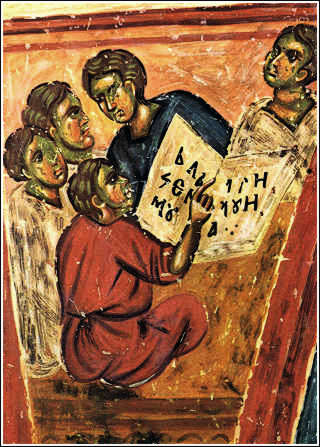Serbian Medieval History
Stefan Uros II Milutin (1282-1321)
![]() The long reign of one of the most illustrious and powerful medieval Serbian figures - the "Holy King Uros", (Milutin by given vernacular name; pr. mee-LOO-tin) - marked the elevation of Serbia to a dominant Balkan position, and saw cultural and economic prosperity and advances along many lines.
The long reign of one of the most illustrious and powerful medieval Serbian figures - the "Holy King Uros", (Milutin by given vernacular name; pr. mee-LOO-tin) - marked the elevation of Serbia to a dominant Balkan position, and saw cultural and economic prosperity and advances along many lines.
The first 17 years or so of the new king's rule witnessed considerable international activity - through much warfare and some diplomacy - most of it south and east against the ailing Byzantine state, some against decentralized Bulgarian interests in the northeast. Much of that was brought to a close with the Serbo-Byzantine peace treaty of 1299, which recognized the new realities of Serb expansion into the mostly South Slavic ethnic space in Macedonia. The agreement was sealed by a high-level royal marriage between the king and emperor Andronikos' minor daughter Simonida (Simonis), and assured a generally cordial relationship between the two courts for the rest of Milutin's reign. Helplessly caught in the middle of court diplomacy was the unhappy young princess; her unlikely moral vindication ultimately came through her fine portrait, well preserved and juxtaposed to the much older king at Gracanica monastery: her firm forceful gaze, having mostly defied visible Ottoman attempts at vandalism and eradication, remained for generations a famous reminder and symbol - as much of defiance as the transcendental triumph of real values over time.
In many ways Milutin's policies show him as a self-styled revivalist and heir to Byzantine traditions and legacy, assuming that the classical establishment on the Bosporus no longer had the moral fortitude and life-bearing energy to carry out its sacred duties. Preserved notes by the leader of the Byzantine embassy during these negotiations, Theodore Metohites, shows at the same time the traditional austerity of the Raskan royal setting, and yet the selective splendor of a court with budding imperial ambition. Much of the Byzantine court ceremonial and protocol was further accepted, and continuity of Greek customs and legal and other institutions was emphasized wherever possible. This was particularly true of the newly acquired Greek areas. In any case, the geopolitical gravitation of his state was clearly more in the southeasterly, Aegean direction, as opposed to the more traditional southwestern, Adriatic one, and this consequently resulted in a visible cultural refocus.
![]() EVERYDAY LIFE, "Children learning the alphabet"
EVERYDAY LIFE, "Children learning the alphabet"
He also built and established several courts, among them Skoplje, which became the most important one, and continued as such during the reigns of his successors.
Of course, none of this would have been possible without a sound economic and trade basis, which was nurtured during this time. While some wealth initially came from that customary but transient martial side-effect - war booty - the stability of Milutin's long reign saw a continued expansion of the fruitful economic policies of his father, Uros I. A burgeoning monetary economy is evidenced by copious output of silver coinage, the later series of which produced some novel and artistic designs. Its aggressiveness also provoked trade sanctions from Venice, and thence - among other things - landed Milutin, "the Raskan king", into Dante's Paradise. Natural resource exploitation and trade patterns were further expanded, and rights and obligations of the various ethno-economic casts (inevitably more socio-economic as time passed: e.g. "Saxs" became a synonym for miners, "Vlachs" for shepherds) were strictly regulated.
Milutin's generosity was legendary, as he erected several dozen monasteries, churches, and hospitals and endowed many more; much of this legacy is still visible today. In Serbia, the most notable examples include the opulent Gracanica monastery near Pristina, King's Church in Studenica, Bogorodica (Virgin) Ljeviska in Prizren, Banjska, and Staro Nagoricino. However, these efforts did not stop at national borders, and his generous foundations and donations can still be witnessed in a wide area ranging from Italy, via Thessalonika and Mt. Athos, to Constantinople and the Holy Land. No doubt sinful at times, Milutin nonetheless retained the conviction of a repentant Christian, and on balance emerged as a saintly figure. His relics lie in the Church of the Holy Week in Sofia, Bulgaria, serving as hope and cure for many faithful to this day.
EVERYDAY LIFE

"Children learning the alphabet" - a scene of timeless innocence, taken from the narration of St. Nicholas' life as told on the walls of King Milutin's foundation Bogorodica Ljeviska in Prizren (Kosovo). Covered for half a millennium under the Ottoman's defacing mortar, its wall paintings came back to life following conservation works in 1953. Along with the rich human stories emerging from Biblical content, they also revealed an Arabic inscription, possibly from the hired vandal: "How beautiful these paintings are!"
Others
More Information
BLAGO Content
While the content of the BLAGO Fund collections is free to use, there are also some restrictions on commercial use and proper attribution of the material. Follow the links below for more information.
> BLAGO Collections License
> Image Request
BLAGO Fund also accepts the contribution of material. Please contact us with any material you wish to publish on our website.
Contact
BLAGO Fund, Inc.
PO Box 60524
Palo Alto, CA 94306
USA
info@blagofund.org

